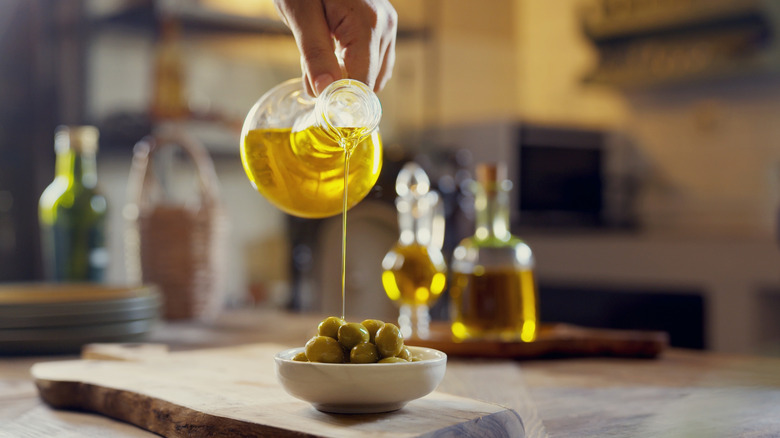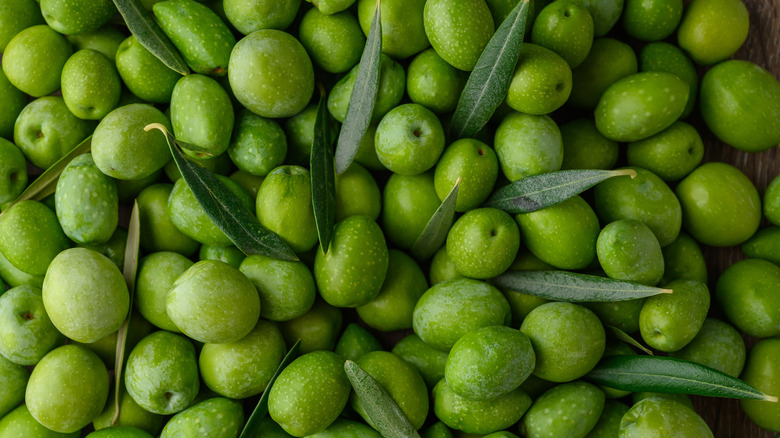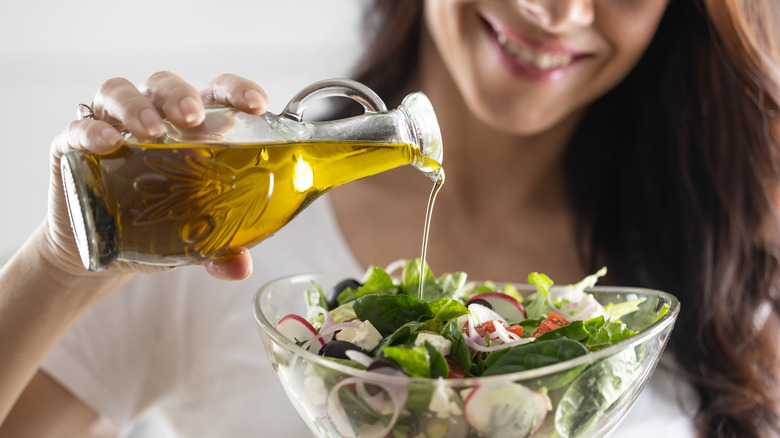Refined Vs Extra Virgin Olive Oil: What's The Difference?
Olive oil — a staple for centuries around the globe, from Europe to North Africa, but did you know that not all olive oils are created equal? Among the many types of olive oil you've probably encountered, "refined" and "extra virgin" are the labels you're most likely to run into on a trip to the store.
But these labels are more than just marketing terms. They denote significant differences in the production methods, quality, and uses. While refined olive oil has undergone treatment to improve imperfections, extra virgin olive oil is all-natural and renowned for its delicious flavor and nutrition. For example, in Spain, the world's largest producer of olive oil, olive oil is made using traditional methods. Due to this laborious production and a selection of high-quality olives, EVOO is more expensive than refined olive oil, but if you're looking for the best taste available, there is just no beating it.
Alternatively, refined olive oil has a more neutral palate and is more suited to being cooked with. And refined olive oil is typically more affordable than extra virgin olive oil, making it a more wallet-friendly option for everyday cooking.
Beyond their culinary applications, these oils also differ in legal classifications. Extra virgin olive oil, often abbreviated as EVOO, must meet rigorous international standards for taste, aroma, and acidity. Understanding the difference can help you make better choices in the kitchen and appreciate what each oil can deliver.
The science behind the different classifications
Refined olive oil is made by combining lower-quality olive oils — oils that haven't met the standards to be considered virgin olive oils – and treating them with heat and chemicals to neutralize any abnormalities in their color, flavor, and acid levels. This refining process also removes a lot of the oils' natural compounds, lending to a paler hue and a milder, more neutral taste. But don't worry – refined olive oils still go through strict international standards for purity and safety, so you can be sure they're safe to consume.
EVOO, on the other hand, is the highest grade of olive oil you can find. It's produced through methods such as cold pressing – where olives are crushed to extract the oil without any heat or chemicals. This all-natural process preserves all the good stuff, so extra virgin olive oil is bursting with antioxidants, vitamins, and polyphenols. The "extra virgin" designation is not just a marketing term; it's a legally defined label. To qualify, the oil must have an acidity level below 0.8% and pass rigorous tests for flavor and aroma.
These tests check for three key flavors — fruitiness, bitterness, and pungency — which all need to be there and perfectly balanced. Plus, EVOO can't have any specific attributes, which are identified as frostbitten, fusty, musty, rancid, or winey. These strict tests make sure only the highest quality oils earn the "extra virgin" label, preserving their amazing flavor and health benefits.
Ways to make the most of each oil
Refined olive oil is perfect for cooking at high heat thanks to its higher smoke point, around 465 degrees Fahrenheit, so use it for frying, grilling, or roasting without the risk of it breaking down. The refining process means it doesn't have the same rich flavor as extra virgin olive oil, but it gets the job done. Think crispy veggies, juicy steaks with a crispy crust, and perfectly golden roasted potatoes.
EVOO, on the other hand, has a lower smoke point of around 325 to 375 degrees Fahrenheit and is best enjoyed raw or in low heat. It's all about flavor and finesse, so drizzle it over salads, pasta, or into homemade hummus. Feeling more adventurous? Giada De Laurentiis swears by EVOO on ice cream. EVOO's grassy, fruity flavor also pairs beautifully with Mediterranean ingredients like feta, olives, roasted veggies like zucchini and tomatoes, and grilled meats like lamb or chicken. For a simpler treat, dip crusty bread into EVOO mixed with balsamic vinegar and a touch of salt.



